North German Lowland Lakes Miss Ecological Water Quality Standards—A Lake Type Specific Analysis
Abstract
1. Introduction
2. Materials and Methods
2.1. Study Sites
2.1.1. Brandenburg Lakes
2.1.2. Catchment Characteristics of the Scharmützelsee Region
2.1.3. Lakes in the Catchment: Deep Lake Scharmützelsee and Shallow Lake Langer See
2.2. Methods and Database
2.2.1. Monitoring Program of the Brandenburg Water Authority 2006–2014
2.2.2. Estimation of Nutrient Input from the Catchment in the Scharmützelsee Region
2.2.3. Long-Term Study of Water Quality in Lake Scharmützelsee and Lake Langer See 1993–2018
3. Results
3.1. Ecological Status of Lakes in Brandenburg, According to WFD in 2014
3.2. Nutrient Inputs from the Catchment—Case Study Scharmützelsee Region
3.3. Long-Term Development of Lake Water Quality after Reduction of Nutrient Input from the Catchment—Case Studies Lake Scharmützelsee and Lake Langer See
4. Discussion
4.1. Lakes Miss Water Quality Goals due to High Nutrient Loads—Ecological Status of Lakes in Brandenburg in 2014
4.2. Effects of Lake Morphometry and Catchment Size—Case Study Scharmützelsee Region
5. Conclusions
Author Contributions
Funding
Acknowledgments
Conflicts of Interest
References
- European Union (EU). Directive 2000/60/EC of the European Parliament and of the Council of 23 October 2000 Establishing a Framework for Community Action in the Field of Water Policy; Official Journal L 327; EU, Publications Office of the European Union: Luxembourg, 2000; Available online: http://eur-lex.europa.eu/resource.html?uri=cellar:5c835afb-2ec6-4577-bdf8-756d3d694eeb.0004.02/DOC_1&format=PDF (accessed on 14 February 2018).
- Carvalho, L.; Mackay, E.B.; Cardoso, A.C.; Baattrup-Pedersen, A.; Birk, S.; Blackstock, K.L.; Borics, G.; Borja, A.; Feld, C.K.; Ferreira, M.T.; et al. Protecting and restoring Europe’s waters: An analysis of the future development needs of the Water Framework Directive. Sci. Total Environ. 2019, 658, 1228–1238. [Google Scholar] [CrossRef] [PubMed]
- European Environment Agency (EEA). Source Apportionment of Nitrogen and Phosphorus Inputs into the Aquatic Environment; EEA Report No. 7/2005; EEA, Office for Official Publications of the European Communities: Copenhagen, Denmark, 2005; Available online: https://www.eea.europa.eu/publications/eea_report_2005_7 (accessed on 27 November 2019).
- Kronvang, B.; Borgvang, S.A.; Barkved, L.J. Towards European harmonised procedures for quantification of nutrient losses from diffuse sources—The EUROHARP project. J. Environ. Monit. 2009, 11, 503–505. [Google Scholar] [CrossRef] [PubMed]
- Birk, S.; Bonne, W.; Borja, A.; Brucet, S.; Courrat, A.; Poikane, S.; Solimini, A.; Van De Bund, W.; Zampoukas, N.; Hering, D. Three hundred ways to assess Europe’s surface waters: An almost complete overview of biological methods to implement the Water Framework Directive. Ecol. Indic. 2012, 18, 31–41. [Google Scholar] [CrossRef]
- Solheim, A.L.; Rekolainen, S.; Moe, S.J.; Carvalho, L.; Phillips, G.; Ptacnik, R.; Penning, W.E.; Toth, L.G.; O’Toole, C.; Schartau, A.-K.L.; et al. Ecological threshold responses in European lakes and their applicability for the Water Framework Directive (WFD) implementation: Synthesis of lakes results from the REBECCA project. Aquat. Ecol. 2008, 42, 317–334. [Google Scholar] [CrossRef]
- Poikane, S.; van den Berg, M.; Hellsten, S.; de Hoyos, C.; Ortiz-Casas, J.; Pall, K.; Portielje, R.; Phillips, G.; Solheim, A.L.; Tierney, D.; et al. Lake ecological assessment systems and intercalibration for the European Water Framework Directive: Aims, achievements and further challenges. Procedia Environ. Sci. 2011, 9, 153–168. [Google Scholar] [CrossRef]
- Länderarbeitsgemeinschaft Wasser (LAWA-AO). In RaKon Monitoring Teil B, Arbeitspapier I—Gewässertypen und Referenzbedingungen; Stand 02.02.2016; LAWA-AO, MELUND: Kiel, Germany, 2016; Available online: http://www.gewaesser-bewertung.de/files/rakon_b-arbeitspapier-i_stand_20160202.pdf (accessed on 14 February 2017).
- Mischke, U.; Riedmüller, U.; Hoehn, E.; Nixdorf, B. Method Description of the Assessment of Lakes and Reservoirs with Phytoplankton and the Phyto-See-Index in Germany. In User Handbook. Excerpt of Original Version December; Electronic Publication: Berlin, Germany, 2016; Available online: http://www.gewaesser-bewertung.de/files/english_handbook_german_lake_assessment_method_description_psi_dec2016-1.pdf (accessed on 27 November 2019).
- Mischke, U.; Böhmer, J.; Riedmüller, U.; Deneke, R.; Maier, G. Auswertungsprogramm PhytoSee Version 7.0 zur Berechnung des Phyto-See-Index (PSI) für die Ökologische Bewertung von Natürlichen, Künstlichen und Erheblich Veränderten Seen in Deutschland Gemäß EG-Wasserrahmenrichtlinie; Erweitert um Das PhytoLoss Modul 1.2 zur Einbindung von Zooplanktonbefunden. Stand 15.12.2017. 2017. Available online: http://www.gewaesser-bewertung.de/files/phytosee-tool_7.0_dez2017.zip (accessed on 14 February 2018).
- Nixdorf, B.; Hoehn, E.; Riedmüller, U.; Mischke, U.; Schönfelder, I. Probenahme und Analyse des Phytoplanktons in Seen und Flüssen zur ökologischen Bewertung gemäß der EU-WRRL. In Handbuch Angewandte Limnologie—Methodische Grundlagen; III-4.3.1; Ergänzungslieferung 4/10, Wiley-VCH Verlag GmbH & Co. KgaA: Weinheim, Germany, 2010; pp. 1–24. [Google Scholar]
- Schaumburg, J.; Schranz, C.; Stelzer, D.; Vogel, A. Verfahrensanleitung für die ökologische Bewertung von Seen zur Umsetzung der EG-Wasserrahmenrichtlinie: Makrophyten und Phytobenthos. PHYLIB. Stand Februar 2014; Bayerisches Landesamt für Umwelt. Im Auftrag der LAWA Projekt-Nr. O 10.10: Augsburg/Wielenbach, Germany, 2015; Available online: http://www.gewaesser-bewertung.de/files/verfahrensanleitung_seen2015.pdf (accessed on 14 February 2018).
- Böhmer, J. Methodisches Handbuch zur WRRL-Bewertung von Seen Mittels Makrozoobethos Gemäß AESHNA—Handbuch zur Untersuchung und Bewertung von Stehgewässern auf der Basis des Makrozoobenthos vor dem Hintergrund der EG-Wasserrahmenrichtlinie; Bioforum GmbH: Kirchheim/Teck, Germany, 2017; Available online: http://www.gewaesser-bewertung.de/files/AESHNA_Anleitung_Endfassung_5-5-17.pdf (accessed on 27 November 2019).
- Ritterbusch, D.; Brämick, U. Verfahrensvorschlag zur Bewertung des ökologischen Zustandes von Seen anhand der Fische (1). Schriften Instituts Binnenfischerei eV 2015, 41, 69. [Google Scholar]
- Bundesministerium für Umwelt und Bau/Umweltbundesamt (BMUB/UBA). Water Framework Directive—The Status of German Waters 2015; BMU/UBA: Bonn/Dessau, Germany, 2016; Available online: http://www.gewaesser-bewertung.de/files/wrrl_englische_version_dez_2016.pdf (accessed on 14 February 2017).
- European Environment Agency (EEA). European Waters—Assessment of Status and Pressures 2018; EEA Report No. 7/2018; European Environment Agency, Publications Office of the European Union: Luxembourg, 2018; Available online: https://www.eea.europa.eu/publications/state-ofwater (accessed on 27 November 2019). [CrossRef]
- Nixdorf, B.; Deneke, R. Why ‘very shallow’ lakes are more successful opposing reduced nutrient loads. Hydrobiologia 1997, 342, 269–284. [Google Scholar] [CrossRef]
- Ministry of Rural Development, Environment and Agriculture of the Federal State of Brandenburg (MLUL). Landschaftswasserhaushalt. MLUL, Potsdam, Germany. Available online: https://lfu.brandenburg.de/cms/detail.php/bb1.c.327798.de (accessed on 28 November 2019).
- Deutscher Wetterdienst (DWD). Niederschlag: Vieljährige Mittelwerte 1981–2010. Available online: https://www.dwd.de/DE/leistungen/klimadatendeutschland/mittelwerte/nieder_8110_akt_html.html?view=nasPublication&nn=16102 (assessed on 30 September 2019).
- Umweltbundesamt (UBA, DLR-DFD). CORINE Land Cover (CLC2006); Umweltbundesamt, DLR-DFD: Weßling, Germany, 2009. [Google Scholar]
- Ministry of Rural Development, Environment and Agriculture of the Federal State of Brandenburg (MLUL). Lagebericht Abwasser 2015; MLUL: Potsdam, Germany, 2015; Available online: http://www.mlul.brandenburg.de/cms/media.php/lbm1.a.3310.de/kawb2015_teil3.pdf (accessed on 2 July 2016).
- Ministry of Rural Development, Environment and Agriculture of the Federal State of Brandenburg (MLUL). Kommunale Kläranlagen und Einleitstellen im Land Brandenburg [kommka.shp; kommeinleit.shp]; Stand 31.12.2011; MLUL: Potsdam, Germany, 2017; Available online: http://www.metaver.de/search/dls/dataset/365B64CD-55CA-4C65-8F48-8B93B9C06E40/4266D9C1-D20B-4922-B8B2-6BA116243CCE (accessed on 14 February 2018).
- Bundesamt für Kartographie und Geodäsie (BKG); BKG, Frankfurt/Main, Germany. Available online: http://sg.geodatenzentrum.de/web_download/vg/vg1000-ew_3112/utm32s/shape/vg1000-ew_3112.utm32s.shape.kompakt.zip (accessed on 23 November 2015).
- Ministry of Rural Development, Environment and Agriculture of the Federal State of Brandenburg (MLUL). Surface catchment areas. MLUL: Potsdam, Germany. Available online: http://www.mugv.brandenburg.de/lua/gis/ezg25.zip (accessed on 9 September 2014).
- Ministry of Rural Development, Environment and Agriculture of the Federal State of Brandenburg (MLUL). Water network. MLUL: Potsdam, Germany. Available online: http://www.mugv.brandenburg.de/lua/gis/gewnet25.zip (accessed on 9 September 2014).
- Ministry of Rural Development, Environment and Agriculture of the Federal State of Brandenburg (MLUL). Surface water bodies. MLUL: Potsdam, Germany. Available online: http://www.mugv.brandenburg.de/lua/gis/seen25.zip (accessed on 9 September 2014).
- Ministry of Rural Development, Environment and Agriculture of the Federal State of Brandenburg (MLUL). Municipal wastewater treatment plants: Potsdam, Germany. Available online: http://www.mlul.brandenburg.de/lua/gis/kommka.zip (accessed on 9 September 2014).
- Grüneberg, B.; Rücker, J.; Nixdorf, B.; Behrendt, H. Dilemma of non-steady state in lakes—Development and predictability of in-lake P concentration in dimictic Lake Scharmützelsee (Germany) after abrupt load reduction. Int. Rev. Hydrobiol. 2011, 96, 599–621. [Google Scholar] [CrossRef]
- Kleeberg, A.; Freidank, A.; Jöhnk, K. Effects of ice cover on sediment resuspension and phosphorus entrainment in shallow lakes: Combining in situ experiments and wind-wave modeling. Limnol. Oceanogr. 2013, 58, 1819–1833. [Google Scholar] [CrossRef]
- Wundsch, H.H. Beiträge zur Fischereibiologie märkischer Seen. VI. Die Entwicklung eines besonderen Seentypus (H2S-Oscillatorien-Seen) im Fluß-Seen-Gebiet der Spree und Havel und seine Bedeutung für die fischereibiologischen Bedingungen in dieser Region. Zeitschrift Fischerei 1940, 38, 443–658. [Google Scholar]
- Kleeberg, A. Re-assessment of Wundsch’s (1940) ‘H2S-Oscillatoria-Lake’ type using the eutrophic Lake Scharmützel (Brandenburg, NE Germany) as an example. Hydrobiologia 2003, 501, 1–5. [Google Scholar] [CrossRef]
- Müller, H. Die produktionsbiologischen Verhältnisse märkischer Seen in der Umgebung Storkows. Zeitschrift Fischerei Hilfswissenschaften 1952, 1, 95–160. [Google Scholar]
- Nixdorf, B.; Mischke, U.; Rücker, J. Phytoplankton assemblages and steady state in deep and shallow eutrophic lakes—An approach to differentiate the habitat properties of Oscillatoriales. Hydrobiologia 2003, 502, 111–121. [Google Scholar] [CrossRef]
- Hilt, S.; Henschke, I.; Rücker, J.; Nixdorf, B. Can submerged macrophytes influence turbidity and trophic state in deep lakes? Suggestions from a case study. J. Environ. Qual. 2010, 39, 725–733. [Google Scholar] [CrossRef] [PubMed]
- Ministerium für Ländliche Entwicklung und Landwirtschaft des Landes Brandenburg (MLUL). Umsetzung der Wasserrahmenrichtlinie: Beiträge des Landes Brandenburg zu den Bewirtschaftungsplänen und Maßnahmenprogrammen der Flussgebietseinheiten Elbe und Oder für den Zeitraum 2016 bis 2021; MLUL: Potsdam, Germany, 2016; Available online: https://lfu.brandenburg.de/cms/media.php/lbm1.a.3310.de/wrrl_2016_gesamt.pdf (accessed on 27 November 2019).
- Rücker, J.; Barsch, A.; Nixdorf, B. „Besser, aber noch nicht gut“—Ökologischer Zustand der Seen in Brandenburg 2014. WasserWirtschaft 2015, 12, 41–47. [Google Scholar] [CrossRef]
- Päzolt, J. Der Makrophytenindex Brandenburg—Ein Index zur Bewertung von Seen mit Makrophyten. Nat. Landsch. Brandenbg. 2007, 16, 116–121. [Google Scholar]
- European Commission, Joint Research Centre (EC, JRC). Water Framework Directive Intercalibration Technical Report; Part 2: Lakes; EC, JRC, Office for Official Publications of the European Communities: Luxembourg, 2009; Available online: https://publications.jrc.ec.europa.eu/repository/bitstream/JRC51340/3009_08-vol-lakes-cover.pdf (accessed on 27 November 2019).
- Johnes, P.J. Evaluation and management of the impact of land use change on the nitrogen and phosphorus load delivered to surface waters: The export coefficient modelling approach. J. Hydrol. 1996, 183, 323–349. [Google Scholar] [CrossRef]
- Behrendt, H.; Huber, P.; Kornmilch, M.; Opitz, D.; Schmoll, O.; Scholz, G.; Uebe, R. Nutrient Emissions into River Basins of Germany. UBA-Texte, 23/00, 2000. Available online: https://www.umweltbundesamt.de/sites/default/files/medien/publikation/long/1837.pdf (accessed on 14 February 2018).
- Landesamt für Umwelt, Gesundheit und Verbraucherschutz des Landes Brandenburg (LUGV). Methodik der Nährstoffbilanzierung in Brandenburg als Grundlage für die Ausweisung von Maßnahmen zur Nährstoffreduzierung für den BWPL 2014; Heft Nr. 144; Fachbeiträge des LUGV: Potsdam OT Groß-Glienicke, Germany, 2015; Available online: http://www.lfu.brandenburg.de/media_fast/4055/fb_144.pdf (accessed on 14 February 2018).
- DEV (Deutsche Einheitsverfahren zur Wasser-, Abwasser- und Schlammuntersuchung). D11, E5, D9, C9, E1, H7; WILEY-VCH Verlag GmbH & Co. KGaA, Beuth Verlag GmbH: Berlin, Germany, 1976–1998. [Google Scholar]
- Utermöhl, H. Zur Vervollkommnung der quantitativen Phytoplankton-Methodik. Mitt. Int. Ver. Theor. Angew. Limnol. 1958, 9, 1–38. [Google Scholar] [CrossRef]
- DEV (Deutsche Einheitsverfahren zur Wasser-, Abwasser- und Schlammuntersuchung). DIN EN 16695:2015-12: Water Quality—Guidance on the Estimation of Phytoplankton Biovolume, German version EN 16695:2015; WILEY-VCH Verlag GmbH & Co. KGaA, Beuth Verlag GmbH: Berlin, Germany, 2015. [Google Scholar] [CrossRef]
- Länderarbeitsgemeinschaft Wasser (LAWA). Trophieklassifikation von Seen. Richtlinie zur Ermittlung des Trophie-Index nach LAWA für natürliche Seen, Baggerseen, Talsperren und Speicherseen. Empfehlungen Oberirdische Gewässer; Access-Tool Version, 1.1; LAWA—Bund/Länder Arbeitsgemeinschaft Wasser, Ed.; Kulturbuchverlag: Berlin, Germany, 2014; ISBN 978-3-88961-345-52014. Available online: http://www.gewaesserfragen.de/pdfs/Auswerte-Tool_Trophie-Index_Seen_nach_LAWA_Version_1.1_Apr2015.zip (accessed on 14 February 2017).
- NITROLIMIT. NITROLIMIT—Stickstofflimitation in Binnengewässern: Ist Stickstoffreduktion ökologisch sinnvoll und wirtschaftlich vertretbar? Abschlussbericht des BMBF-Verbundprojekts NITROLIMIT I, Mai 2014; BTU Cottbus–Senftenberg, Lehrstuhl Gewässerschutz: Bad Saarow, Germany, 2014; p. 208. Available online: http://www-docs.tu-cottbus.de/gewaesserschutz/public/downloads/NITROLIMIT_Endbericht_Mai2014.pdf (accessed on 5 July 2016).
- Vollenweider, R.A. Advances in defining critical loading levels for phosphorus in lake eutrophication. Memorie Istituto Italiano Idrobiologia 1976, 33, 53–83. [Google Scholar]
- Organization for Economic Cooperation and Development (OECD). Eutrophication of Waters—Monitoring, Assessment and Control; OECD: Paris, France, 1982. [Google Scholar]
- Nürnberg, G.K. The prediction of internal phosphorus load in lakes with anoxic hypolimnia. Limnol. Oceanogr. 1984, 29, 111–124. [Google Scholar] [CrossRef]
- Sas, H. Lake Restoration by Reduction of Nutrient Loading. Expectations, Experiences, Extrapolations; Academia Richarz: Sankt Augustin, Germany, 1989; p. 497. [Google Scholar]
- Brett, M.T.; Benjamin, M.M. A review and reassessment of lake phosphorus retention and the nutrient loading concept. Freshw. Biol. 2008, 53, 194–211. [Google Scholar] [CrossRef]
- Dolman, A.M.; Mischke, U.; Wiedner, C. Lake-type-specific seasonal patterns of nutrient limitation in German lakes, with target nitrogen and phosphorus concentrations for good ecological status. Freshw. Biol. 2016, 61, 444–456. [Google Scholar] [CrossRef]
- Fastner, J.; Rücker, J.; Stüken, A.; Preußel, K.; Nixdorf, B.; Chorus, I.; Köhler, A.; Wiedner, C. Occurrence of the cyanobacterial toxin cylindrospermopsin in Northeast Germany. Environ. Toxicol. 2007, 22, 26–32. [Google Scholar] [CrossRef] [PubMed]
- Dolman, A.M.; Rücker, J.; Pick, F.R.; Fastner, J.; Rohrlack, T.; Mischke, U.; Wiedner, C. Cyanobacteria and cyanotoxins: The influence of nitrogen versus phosphorus. PLoS ONE 2012, 7, e38757. [Google Scholar] [CrossRef] [PubMed]
- NOSTOTOX. Development of Toxic Nostocales (Cyanobacteria) in the Course of Declining Trophic State and Global Warming. In Final Report of the Joint Research Project NOSTOTOX; IGB: Berlin, Germany, 2011; Available online: https://www-docs.b-tu.de/fg-gewaesserschutz/public/projekte/Nostotox_final_2011_web.pdf (accessed on 14 July 2016).
- German Environment Agency. Waters in Germany: Status and Assessment; German Environment Agency: Dessau-Roßlau, Germany, 2017; ISSN 2363-832X. Available online: http://www.gewaesser-bewertung.de/files/171018_uba_gewasserdtl_engl_bf.pdf (accessed on 14 February 2018).
- Moss, B.; Jeppesen, E.; Søndergaard, M.; Lauridsen, T.L.; Liu, Z. Nitrogen, macrophytes, shallow lakes and nutrient limitation: Resolution of a current controversy? Hydrobiologia 2013, 710, 3–21. [Google Scholar] [CrossRef]
- Nixdorf, B.; Rücker, J.; Grüneberg, B. Importance of internal nitrogen recycling on water quality and cyanobacterial biomass in a shallow polymictic lake (Lake Langer See, Germany). In Proceedings of the 3rd International Conference Water Resources and Wetlands, Tulcea, Romania, 8–10 September 2014; Gâştescu, P., Bretcan, P., Eds.; Asociatia Romana de Limnogeografie: Bukarest, Romania, 2016; pp. 38–46, ISSN 2285-7923. Available online: https://www.limnology.ro/wrw2016/proceedings/4_Brigitte_Nixdorf.pdf (accessed on 14 February 2018).
- Positionspapier des Projekts NITROLIMIT—Stickstofflimitation in Binnengewässern—Ist Stickstoffreduktion Ökologisch Sinnvoll und Wirtschaftlich Vertretbar? Wiedner, C., Schlief, J., Eds.; NITROLIMIT: Bad Saarow, Germany, 2016; Available online: https://opus4.kobv.de/opus4-btu/frontdoor/index/index/docId/4019 (accessed on 27 November 2019).
- Rothe, M.; Kleeberg, A.; Grüneberg, B.; Friese, K.; Pérez-Mayo, M.; Hupfer, M. Sedimentary Sulphur: Iron Ratio Indicates Vivianite Occurrence: A Study from Two Contrasting Freshwater Systems. PLoS ONE 2015, 10, e0143737. [Google Scholar] [CrossRef]
- Poikane, S.; Kelly, M.G.; Herrero, F.S.; Pitt, J.-A.; Jarvie, H.P.; Claussen, U.; Leujak, W.; Lyche Solheim, A.; Teixeira, H.; Phillips, G. Nutrient criteria for surface waters under the European Water Framework Directive: Current state-of-the-art, challenges and future outlook. Sci. Total Environ. 2019, 695, 133888. [Google Scholar] [CrossRef]
- Launhardt, A.; Rücker, J.; Nixdorf, B. Control of seasonal phytoplankton dynamics in Lake Scharmützelsee (northeast Germany) by nutrient competition during winter. Verh. Internat. Verein. Limnol. 2006, 29, 1675–1678. [Google Scholar] [CrossRef]
- Jeppesen, E.; Søndergaard, M.; Meerhoff, M.; Lauridsen, T.L.; Jensen, J.P. Shallow lake restoration by nutrient loading reduction-some recent findings and challenges ahead. Hydrobiologia 2007, 584, 239–252. [Google Scholar] [CrossRef]
- Scheffer, M.; Hosper, S.H.; Meijer, M.-L.; Moss, B.; Jeppesen, E. Alternative equilibria in shallow lakes. Trends Ecol. Evol. 1993, 8, 275–279. [Google Scholar] [CrossRef]
- Hilt, S.; Nuñez, A.; Marta, M.; Bakker, E.S.; Blindow, I.; Davidson, T.A.; Gillefalk, M.; Hansson, L.-A.; Janse, J.H.; Janssen, A.B.G.; et al. Response of Submerged Macrophyte Communities to External and Internal Restoration Measures in North Temperate Shallow Lakes. Front. Plant Sci. 2018, 9, 194. [Google Scholar] [CrossRef] [PubMed]
- Dokulil, M.T.; Teubner, K. Eutrophication and Climate Change: Present Situation and Future Scenarios. In Eutrophication: Causes, Consequences and Control; Ansari, A., Singh Gill, S., Lanza, G., Rast, W., Eds.; Springer: Dordrecht, The Netherlands, 2010. [Google Scholar] [CrossRef]
- Jeppesen, E.; Søndergaard, M.; Liu, Z. Lake Restoration and Management in a Climate Change Perspective: An Introduction. Water 2017, 9, 122. [Google Scholar] [CrossRef]
- Nixdorf, B.; Rücker, J.; Deneke, R.; Grüneberg, B. Gewässer im Klimastress? Eutrophierungsgefahr in Seen am Beispiel der Scharmützelseeregion. Forum Forschung 2009, 22, 99–106. [Google Scholar]
- Länder Arbeitsgemeinschaft Wasser (LAWA). Gewässerbewertung—Stehende Gewässer—Vorläufige Richtlinie für eine Erstbewertung von Natürlich Entstandenen Seen Nach Trophischen Kriterien 1998; Kulturbuch: Berlin, Germany, 1999; ISBN 3-88961-225-3. Available online: http://www.lawa.de/documents/Gewaesserbewertung_stehende_Gewaesser_2_4ed_copy_589.pdf (accessed on 14 February 2017).
- Arheimer, B.; Andersson, L.; Alkan-Olsson, J.; Jonsson, A. Using catchment models to establish measure plans according to the Water Framework Directive. Water Sci. Technol. 2007, 56, 21–28. [Google Scholar] [CrossRef]
- Volk, M.; Liersch, S.; Schmidt, G. Towards the implementation of the European Water Framework Directive? Lessons learned from water quality simulations in an agricultural watershed. Land Use Policy 2009, 26, 580–588. [Google Scholar] [CrossRef]
- Jeppesen, E.; Søndergaard, M.; Jensen, J.P.; Havens, K.E.; Anneville, O.; Carvalho, L.; Coveney, M.F.; Deneke, R.; Dokulil, M.T.; Foy, B.; et al. Lake responses to reduced nutrient loading—An analysis of contemporary long term data from 35 case studies. Freshw. Biol. 2005, 50, 1747–1770. [Google Scholar] [CrossRef]
- Lindim, C.; Becker, A.; Grüneberg, B.; Fischer, H. Modelling the effects of nutrient loads reduction and testing the N and P control paradigm in a German shallow lake. Ecol. Eng. 2015, 82, 415–427. [Google Scholar] [CrossRef]
- Hupfer, M.; Reitzel, K.; Grüneberg, B. Methods for measuring internal loading. In Internal Phosphorus Loading in Lakes: Causes, Case Studies, and Management; Steinman, A.D., Spears, B.M., Eds.; J. Ross Publishing: Plantation, FL, USA, 2019. [Google Scholar]
- German Advisory Council on the Environment (SRU). NITROGEN: Strategies for Resolving an Urgent Environmental Problem. Summary. January 2015; SRU: Berlin, Germany, 2015; Available online: http://www.umweltrat.de/SharedDocs/Downloads/EN/02_Special_Reports/2012_2016/2015_01_Nitrogen_Strategies_summary.pdf?__blob=publicationFile (accessed on 27 November 2019).
- German Advisory Council on the Environment (SRU). Sondergutachten Stickstoff: Lösungsstrategien für ein Drängendes Umweltproblem; SRU: Berlin, Germany, 2015; Available online: http://dip21.bundestag.de/dip21/btd/18/040/1804040.pdf (accessed on 20 July 2016).
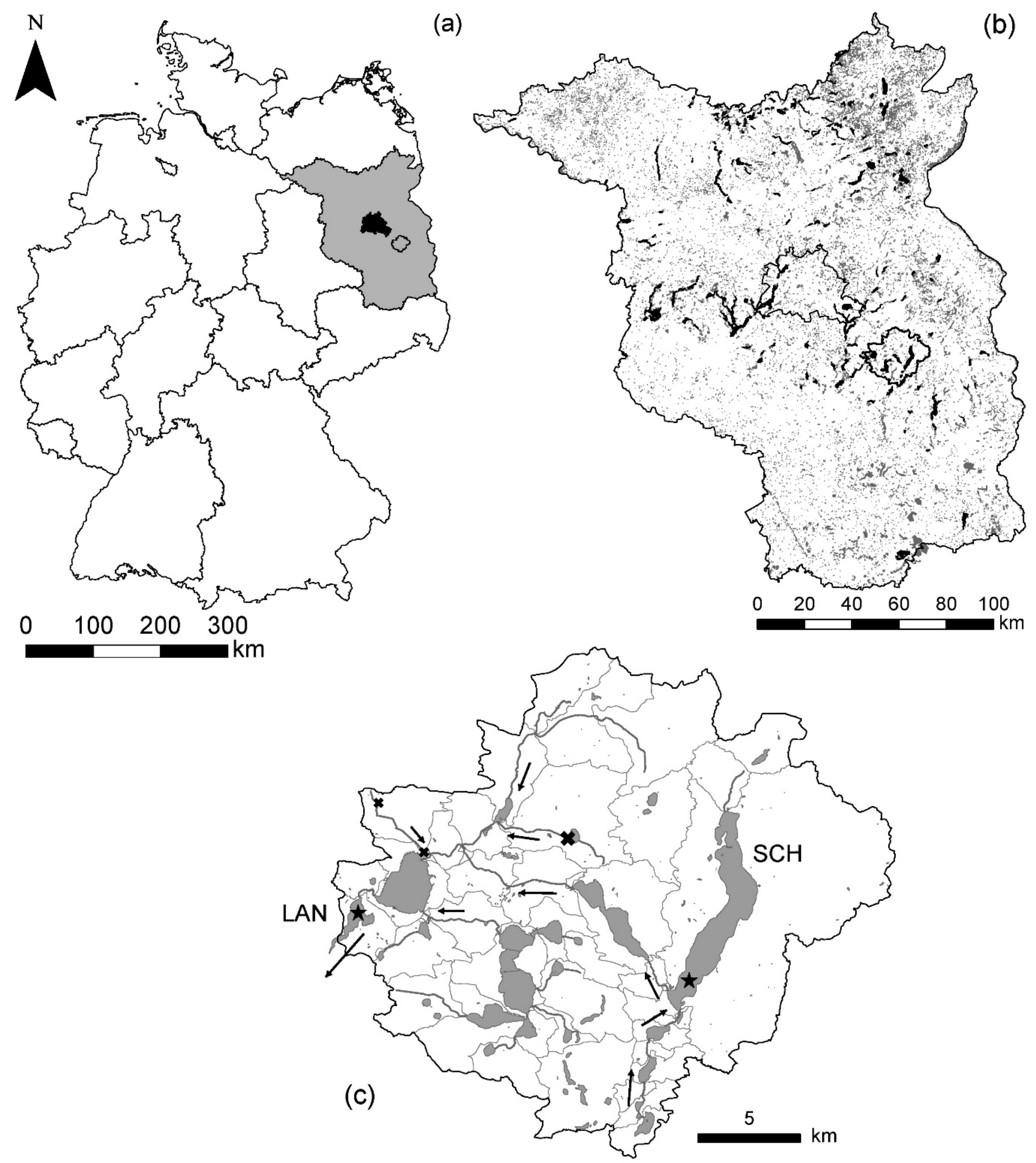
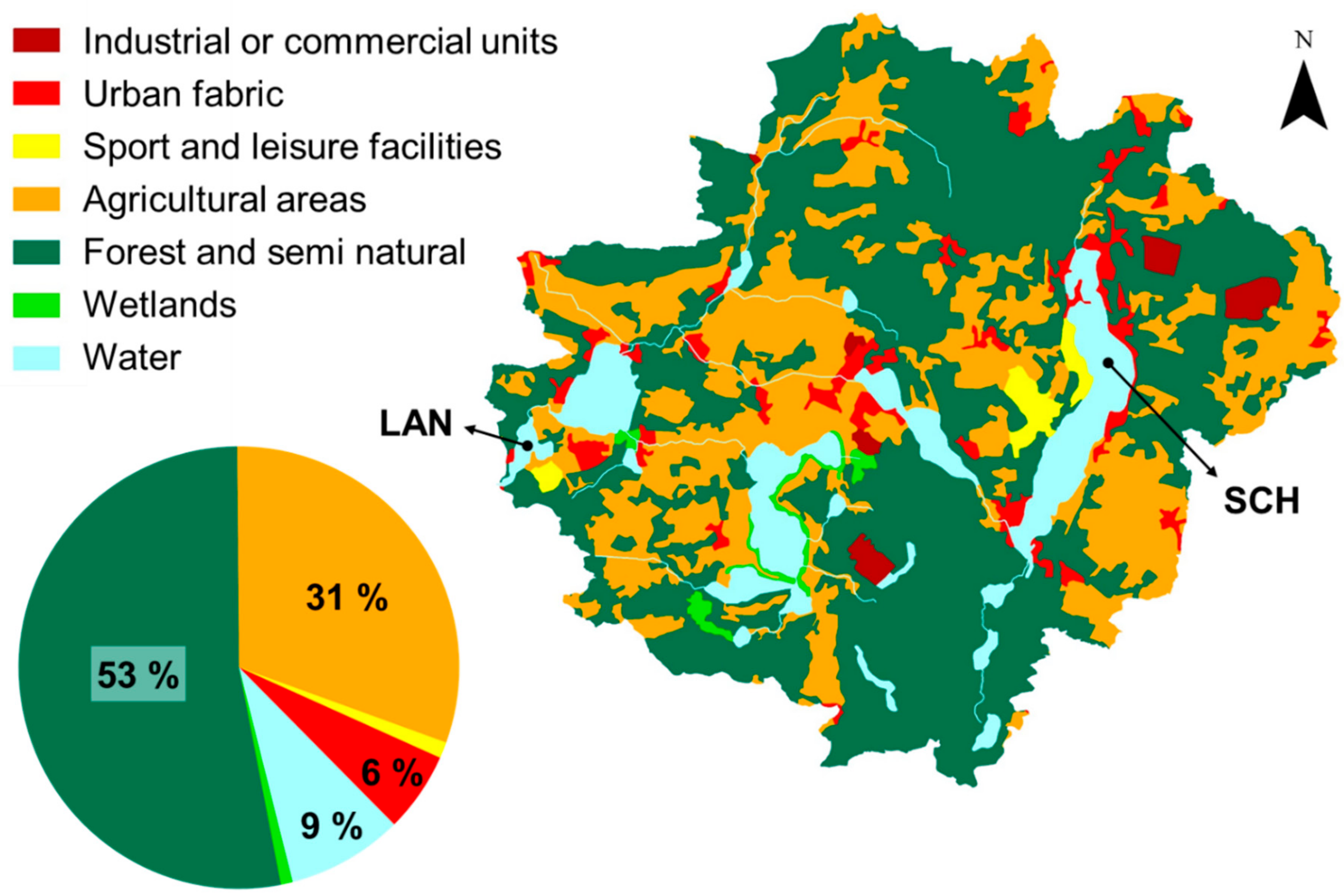
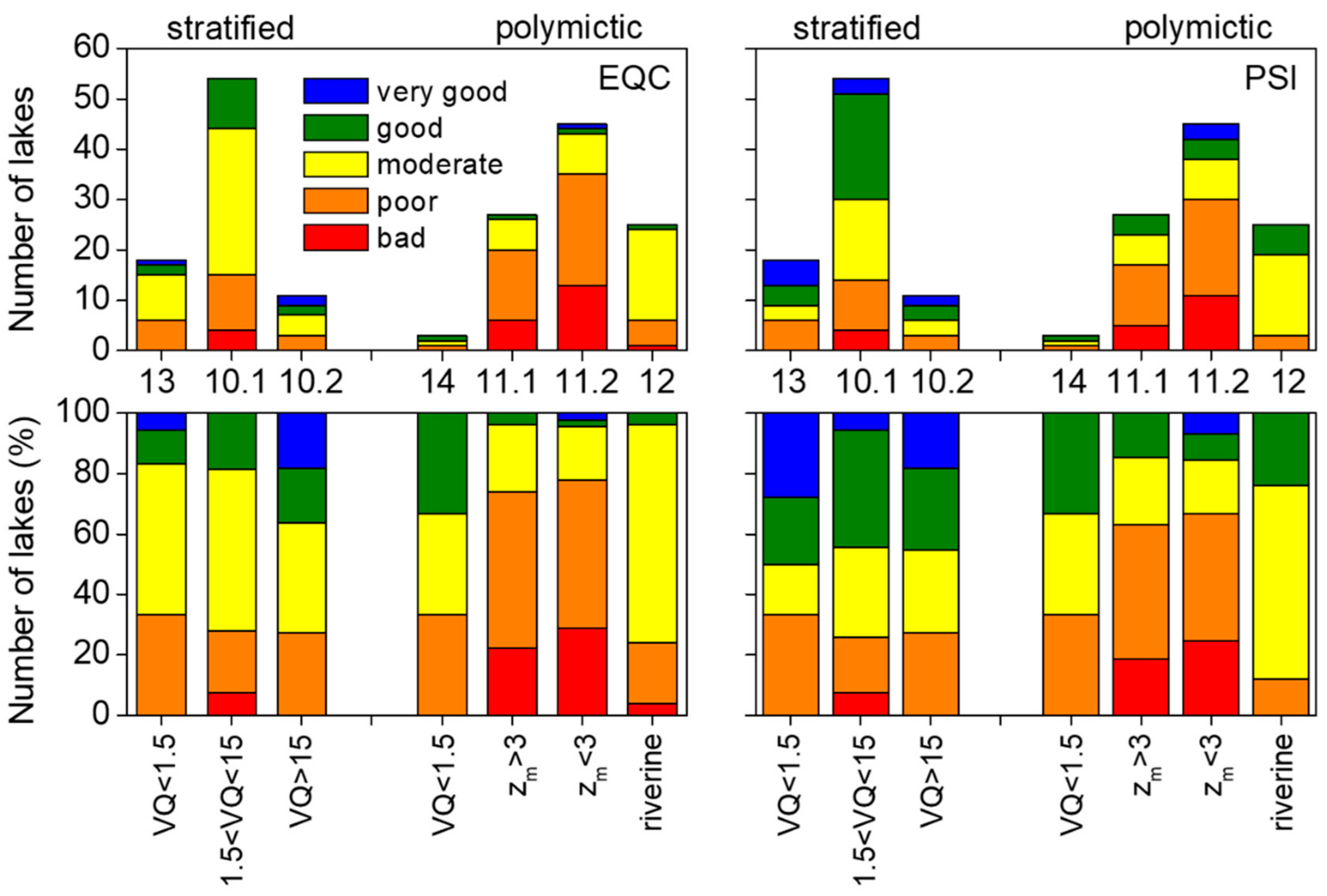
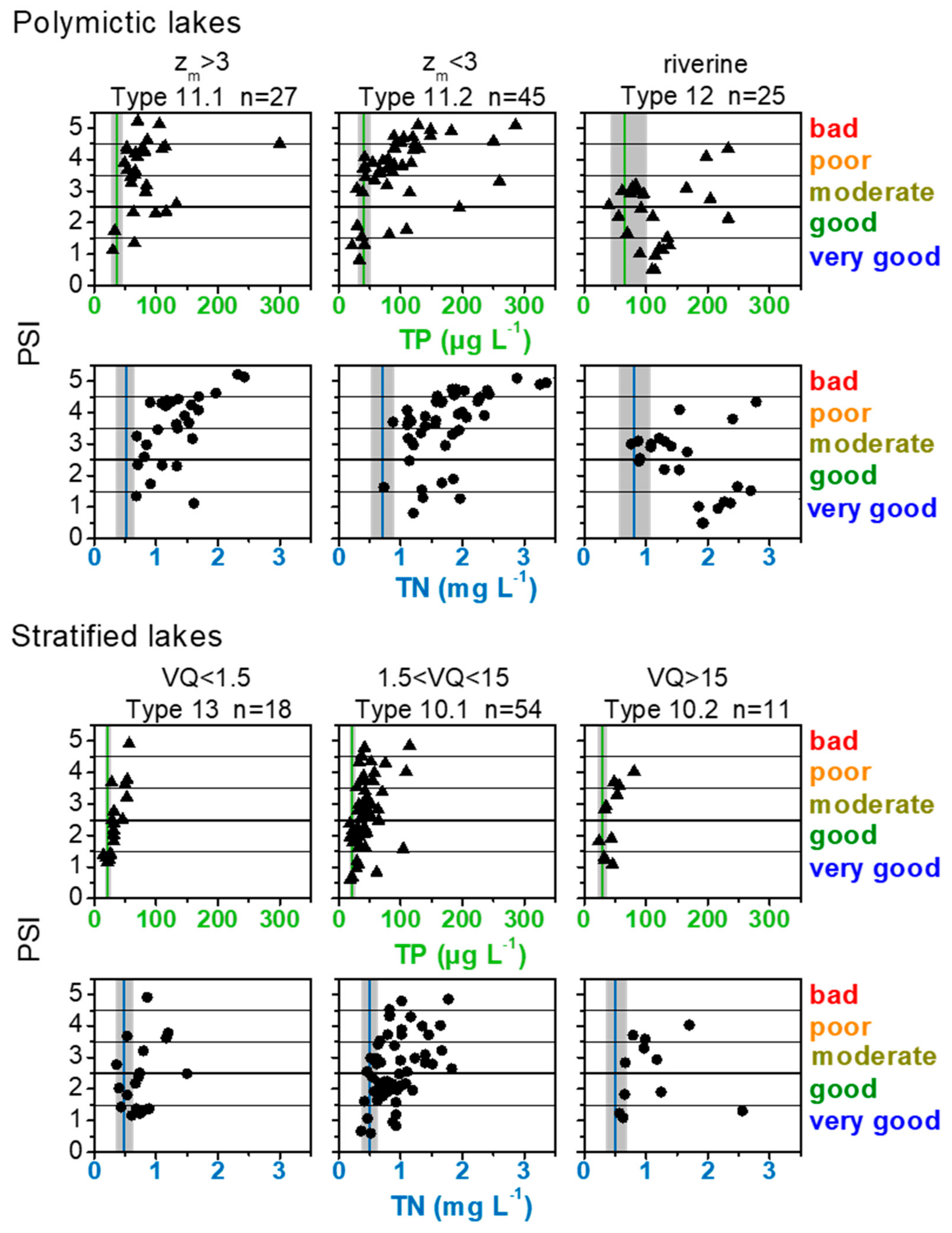
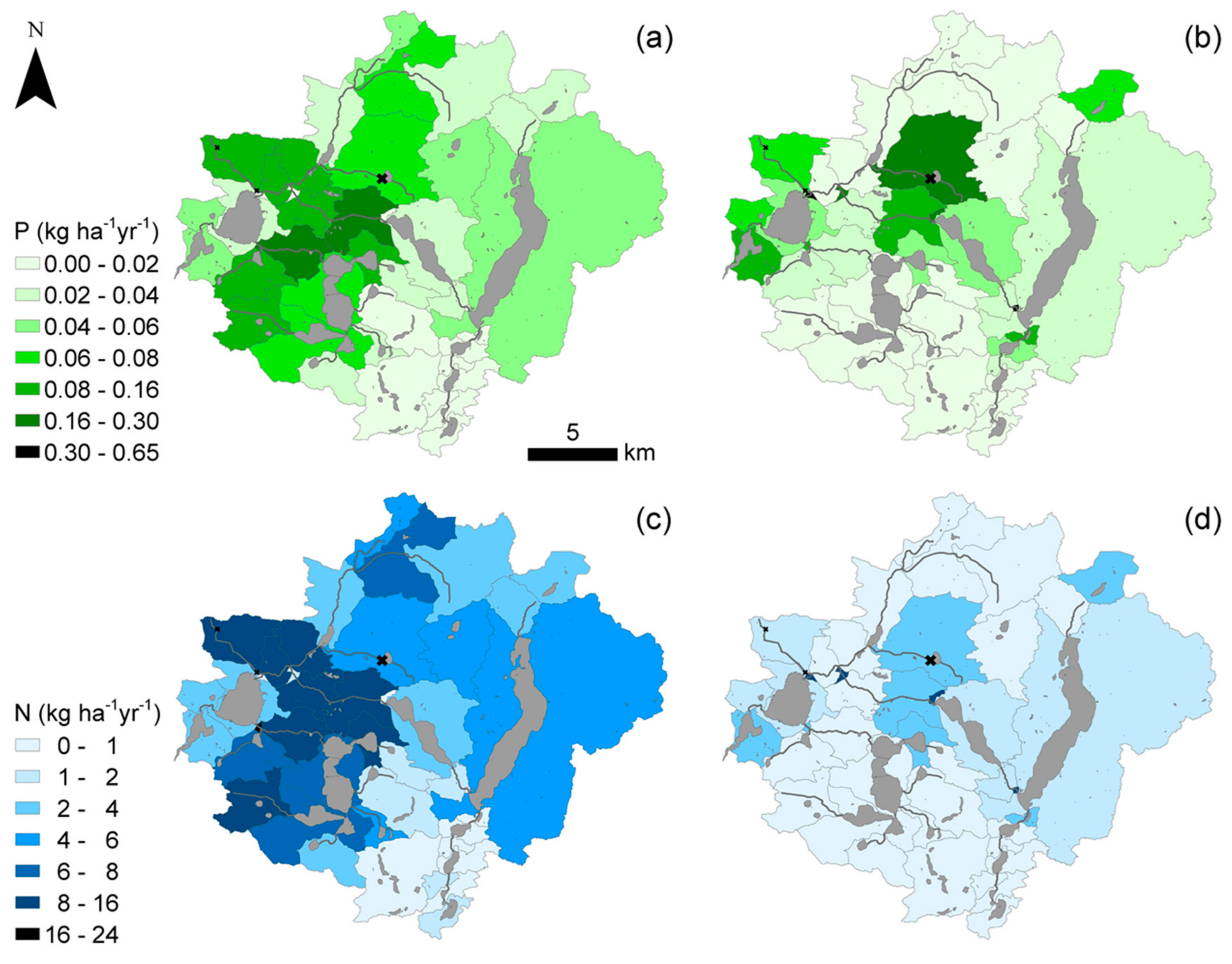
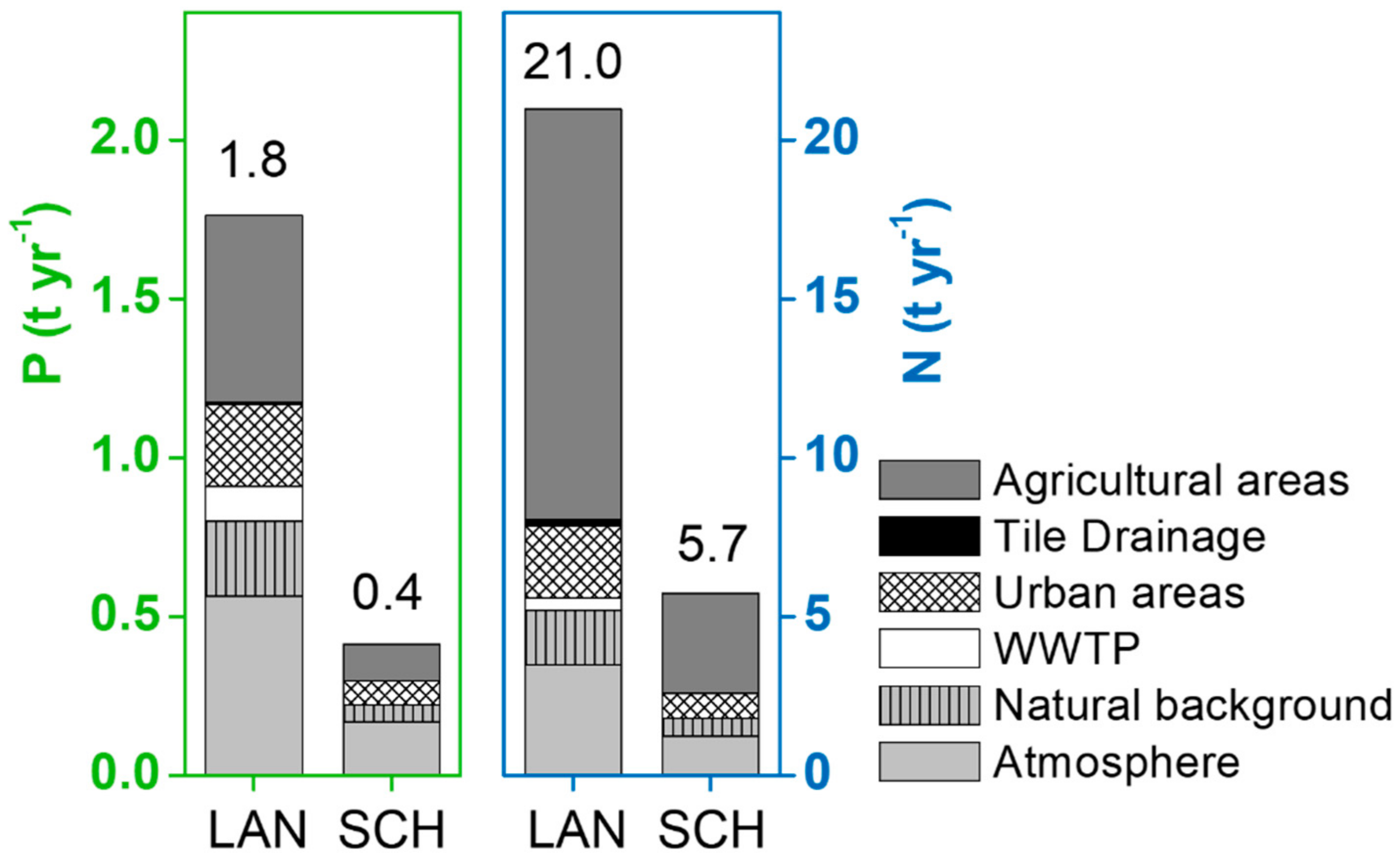
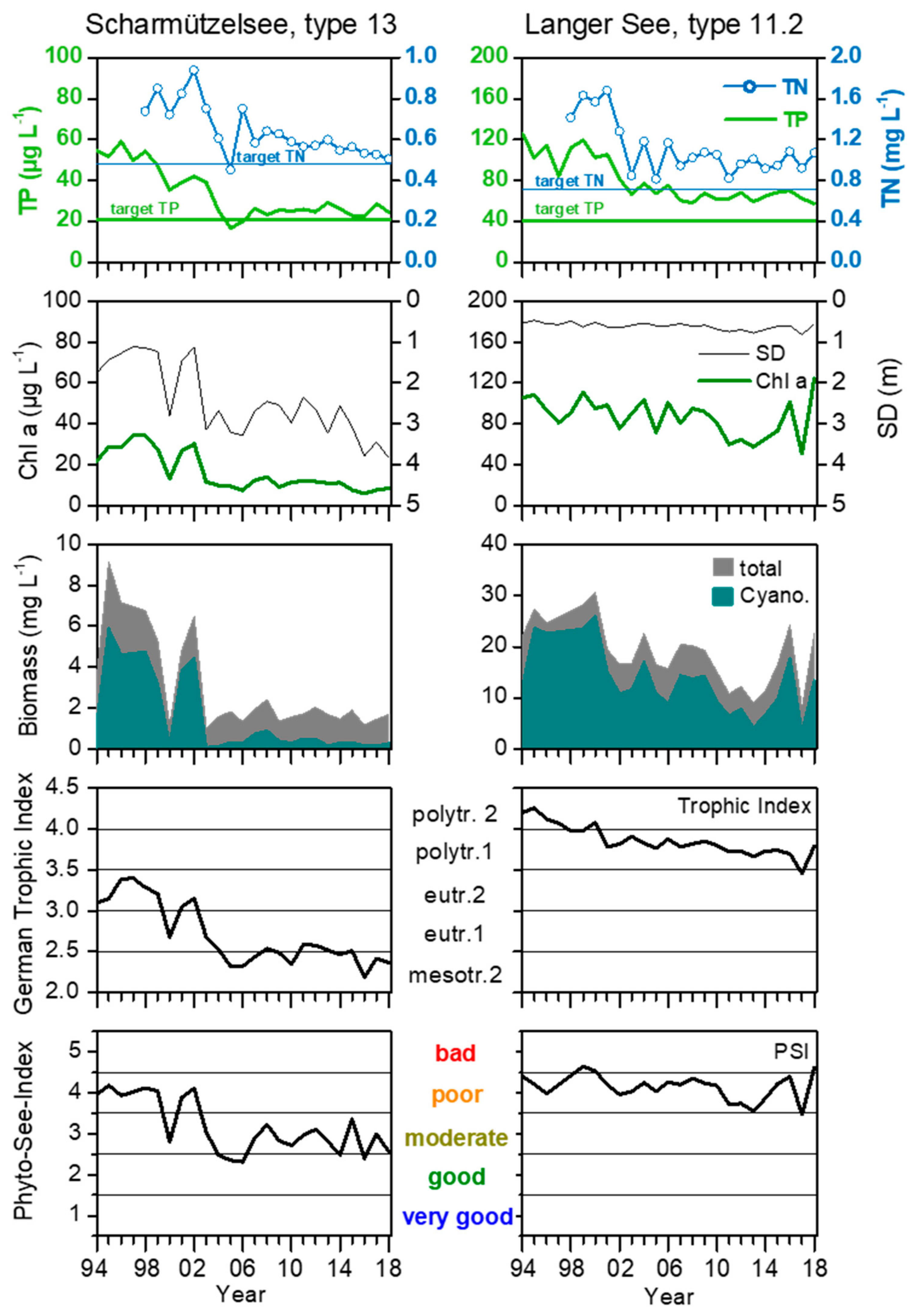
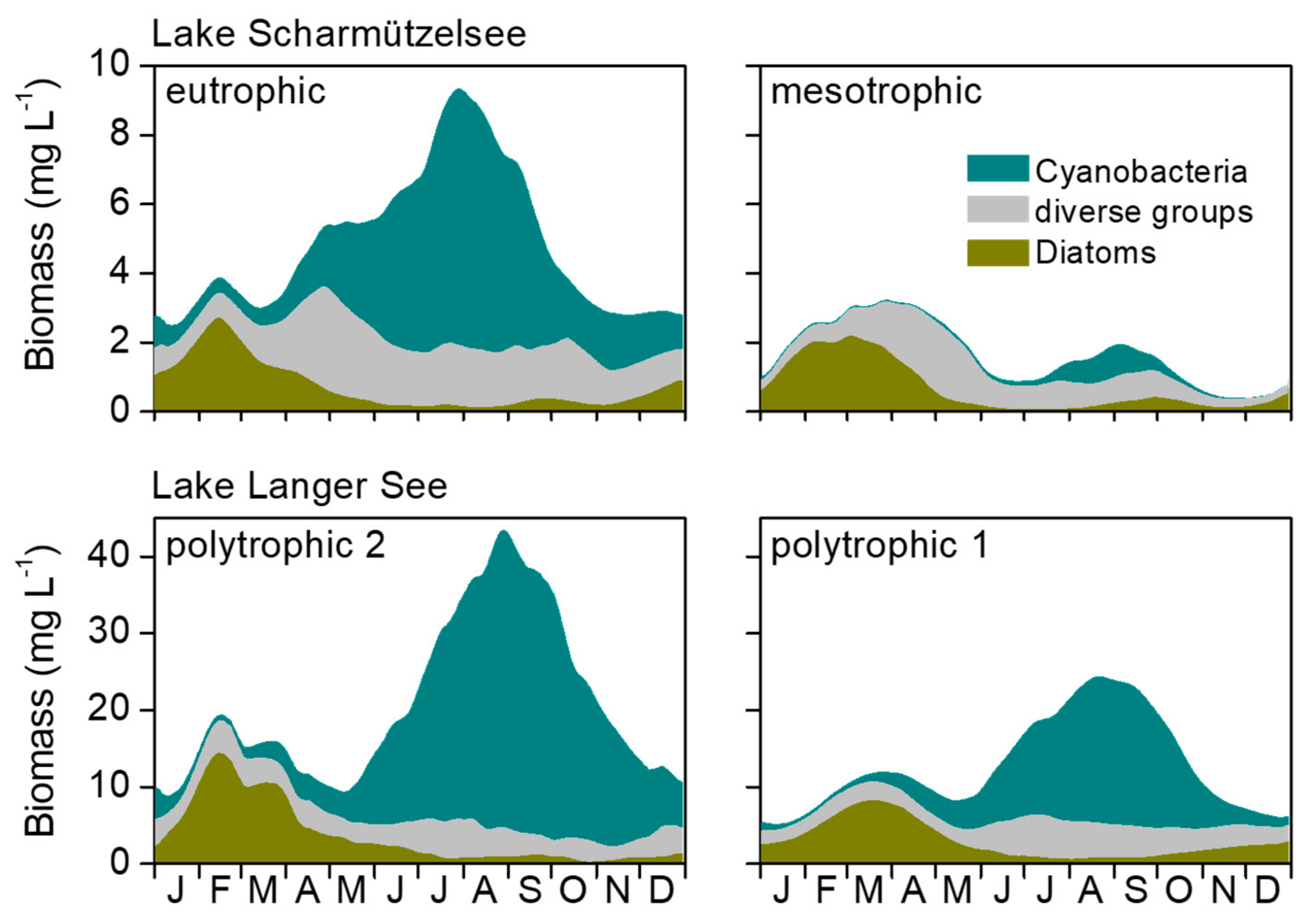
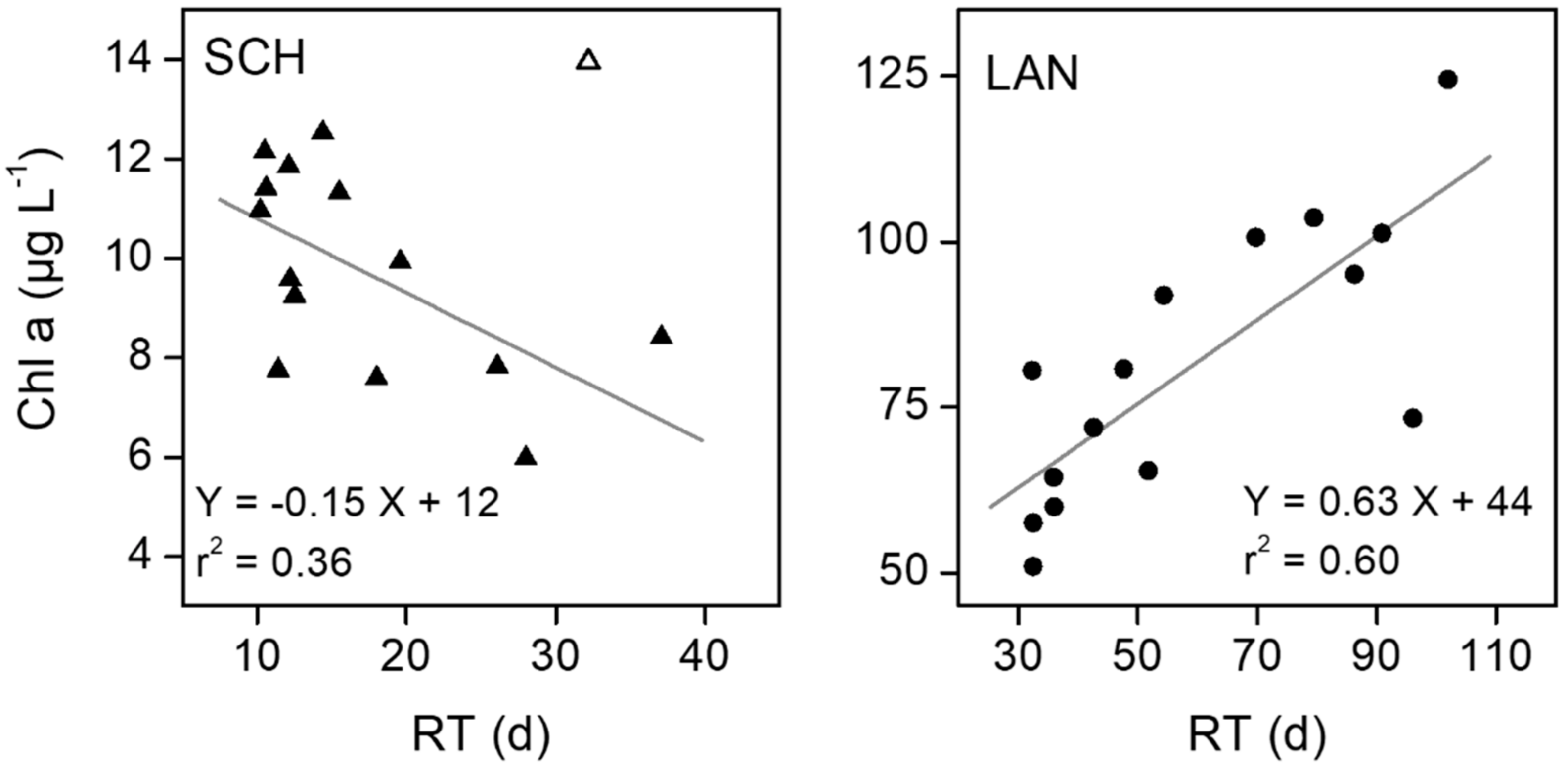
| Scharmützelsee (SCH) | Langer See (LAN) | |
|---|---|---|
| Geographic coordinates (WGS84) | 52°15′ N, 14°03′ E | 52°14′ N, 13°47′ E |
| Catchment area (km2) | 127 | 392 |
| Lake area (km2) | 12.1 | 1.3 |
| Lake volume (Mio. m3) | 108.2 | 2.84 |
| Catchment to volume ratio (m−1) | 1.2 | 138 |
| Shore length (km) | 30.3 | 8.4 |
| Maximum depth (m) | 29.5 | 3.8 |
| Mean depth (m) | 8.9 | 2.2 |
| Mean daily discharge (m3 s−1) | 0.35 (0.22–0.47) | 1.03 (0.70–1.44) |
| Hydraulic residence time (a) | 10.3 (7.4–15.8) | 0.09 (0.06–0.13) |
| Type of mixis | dimictic | polymictic |
| Lake type according to WFD [8,9] | 13 (stratified hard water lake with small catchment) | 11.2 (very shallow hard water lake with large catchment) |
| DE Type | PP Type | Mixis | VQ | zm | RT | IC Type |
|---|---|---|---|---|---|---|
| 10 | 10.1 | stratified | 1.5–15 | L-CB1 | ||
| 10.2 | >15 | |||||
| 13 | 13 | ≤1.5 | ||||
| 11 | 11.1 | polymictic | >1.5 | >3 m | ||
| 11.2 | >1.5 | ≤3 m | L-CB2 | |||
| 14 | 14 | ≤1.5 | ||||
| 12 | 12 | riverine | >1.5 | 3–30 d |
| Lake Scharmützelsee (Type 13) | Lake Langer See (Type 11.2) | |||||
|---|---|---|---|---|---|---|
| 1994–2003 | 2004–2018 | Target Value Critical Load | 1994–2003 | 2004–2018 | Target Value Critical Load | |
| Input data, mean (minimum–maximum) | ||||||
| Mean annual discharge | 11.7 (8.6–14.7) | 10.5 (6.9–13.9) | 33.5 (23.5–45.3) | 31.7 (22.2–43.9) | ||
| (106 m3 yr−1) | ||||||
| Total P (µg L−1) | 59.6 (48.6–78.6) | 38.4 (33.9–44.4) | 21 (18–25) | 99.9 (71.4–124.6) | 67.7 (55.3–76.4) | 41 (32–51) |
| Total N (mg L−1) | 0.87 (0.82–0.94) | 0.65 (0.55–0.74) | 0.48 (0.35–0.62) | 1.27 (0.81–1.49) | 1.06 (0.84–1.17) | 0.71 (0.52–0.88) |
| Nutrient load, mean (±standard deviation) | ||||||
| P load (t yr−1) | 3.3 (±1.0) | 1.9 (±0.4) | 1.6 (±0.3) | 6.5 (±2.8) | 3.9 (±1.3) | 2.5 (±0.7) |
| Area-specific P load (g m−2 yr−1) | 0.27 (±0.08) | 0.16 (±0.03) | 0.14 (±0.02) | 4.6 (±2.0) | 2.8 (±0.9) | 1.7 (±0.5) |
| N load (t yr−1) | 32.8 (±5.3) | 20.8 (±3.9) | 14.8 (±1.8) | 50.6 (±14.1) | 36.2 (±8.9) | 24.1 (±4.8) |
| Area-specific N load (g m−2 yr−1) | 2.7 (±0.4) | 1.7 (±0.3) | 1.2 (±0.2) | 35.8 (±10.0) | 25.7 (±6.3) | 17.0 (±3.4) |
| Scharmützelsee | Langer See | |
|---|---|---|
| Lake type acc. to WFD [8,9] | 13 (stratified hard water lake with small catchment) | 11.2 (very shallow hard water lake with large catchment) |
| Total phosphorus (µg L−1) | 17–29 | 58–77 |
| Total nitrogen (mg L−1) | 0.45–0.75 | 0.81–1.18 |
| Secchi depth (m) | 2.4–3.8 | 0.5–0.8 |
| Chlorophyll a (µg L−1) | 6–14 | 51–125 |
| Phytoplankton biovolume (mm3 L−1) | 1.2–2.4 | 9.1–24.2 |
| German Trophic Index and trophic status acc. to LAWA [45] | 2.2–2.6 (mesotrophic – eutrophic) | 3.5–3.9 (polytrophic 1) |
| Assessment of phytoplankton (PSI) [9] | 2.3–3.4 (moderate) | 3.5–4.6 (poor) |
| Assessment of submerged macrophytes (PHYLIB) [12] | 3.0 (moderate) | 4.9 (bad) |
© 2019 by the authors. Licensee MDPI, Basel, Switzerland. This article is an open access article distributed under the terms and conditions of the Creative Commons Attribution (CC BY) license (http://creativecommons.org/licenses/by/4.0/).
Share and Cite
Rücker, J.; Nixdorf, B.; Quiel, K.; Grüneberg, B. North German Lowland Lakes Miss Ecological Water Quality Standards—A Lake Type Specific Analysis. Water 2019, 11, 2547. https://doi.org/10.3390/w11122547
Rücker J, Nixdorf B, Quiel K, Grüneberg B. North German Lowland Lakes Miss Ecological Water Quality Standards—A Lake Type Specific Analysis. Water. 2019; 11(12):2547. https://doi.org/10.3390/w11122547
Chicago/Turabian StyleRücker, Jacqueline, Brigitte Nixdorf, Katrin Quiel, and Björn Grüneberg. 2019. "North German Lowland Lakes Miss Ecological Water Quality Standards—A Lake Type Specific Analysis" Water 11, no. 12: 2547. https://doi.org/10.3390/w11122547
APA StyleRücker, J., Nixdorf, B., Quiel, K., & Grüneberg, B. (2019). North German Lowland Lakes Miss Ecological Water Quality Standards—A Lake Type Specific Analysis. Water, 11(12), 2547. https://doi.org/10.3390/w11122547






